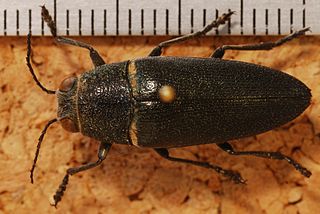Sphenoptera jugoslavica is a species in the family Buprestidae, in the order Coleoptera ("beetles"). A common name for Sphenoptera jugoslavica is "bronze knapweed root borer". The distribution range of Sphenoptera jugoslavica includes Europe, Northern Asia, and North America.
Agrilus gillespiensis is a species in the family Buprestidae, in the order Coleoptera ("beetles"). It is found in North America.
Chalcophora fortis is a species in the family Buprestidae, in the order Coleoptera ("beetles"). It is found in North America.
Agrilus mimosae is a species of metallic wood-boring beetle in the family Buprestidae. The distribution range of Agrilus mimosae includes Central America and North America.

Hippomelas planicauda is a species in the family Buprestidae, in the order Coleoptera ("beetles"). The distribution range of Hippomelas planicauda includes Central America and North America.
Acmaeodera rubrocuprea is a species in the family Buprestidae, in the suborder Polyphaga . The distribution range of Acmaeodera rubrocuprea includes Central America and North America.
Agrilus limpiae is a species in the family Buprestidae, in the suborder Polyphaga . It is found in North America.
Texania campestris is a species in the family Buprestidae, in the suborder Polyphaga. The species is known generally as the "hardwood heartwood buprestid". It is found in North America.
Agrilus latifrons is a species of metallic wood-boring beetles in the family Buprestidae. It is found in Central America and North America.
Hesperorhipis hyperbola is a species of metallic wood-boring beetles in the family Buprestidae. It is found in North America.

Buprestis langii is a species of metallic wood-boring beetles in the family Buprestidae. It is found in North America.
Buprestini is a tribe of metallic wood-boring beetles in the family Buprestidae. There are about eight genera in Buprestini.
Agrilus rubroniger is a species of metallic wood-boring beetles in the family Buprestidae. It is found in North America.
Dicerca hesperoborealis is a species of metallic wood-boring beetles in the family Buprestidae. It is found in North America.
Agrilus hespenheidei is a species of metallic wood-boring beetle in the family Buprestidae. It is found in North America.
Acmaeodera holsteni, or Holsten's flower buprestid, is a species of metallic wood-boring beetle in the family Buprestidae. It is found in North America.

Agrilaxia flavimana is a species of metallic wood-boring beetle in the family Buprestidae. It is found in Central America and North America.

Chrysobothrini is a tribe of metallic wood-boring beetles in the family Buprestidae. There are at least 3 genera and 140 described species in Chrysobothrini.
Agrilus dozieri is a species of metallic wood-boring beetle in the family Buprestidae. It is found in North America.
Buprestis apricans, the turpentine borer, is a species of metallic wood-boring beetle in the family Buprestidae. It is found in the Caribbean and North America.




